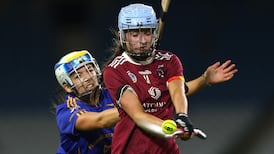Conor McManus summarised the situation well.
Contributing to the Sunday Game at the weekend the Monaghan footballer – from the unwanted and unwonted perspective of just a second year in seven of not being in the last eight – said that whereas most players loved playing at Croke Park, the impact of mediocre crowds in such a big stadium was deflating.
There’s only one round of matches left in this year’s quarter-finals, meaning the trial period could be nearly over, as it’s not yet clear whether the congress or special congress to consider the future of the football championship format will be held before or after the third year of the experiment.
If this sounds daft, it’s because of the potential need to leave enough time to reconfigure the structure should the trial format be discontinued. Then again, a special congress in September 2020 would surely leave sufficient time for that as well as permitting the third year of the experiment to be taken into account.
A significant influence on the outcome will be the findings the key task force on calendar review whose terms of reference include: ‘. . . timing and structure of the main senior inter-county competitions (pre-season, league and championship) including the need for a closed season.’
This is due to report in November of this year with recommendations tabled for discussion at next February’s annual congress.
In the meantime what do we make of the experimental championship structure – now that the probationary period is possibly nearly over?
Central Council will conduct its own review in September and last year there was a tweak to the system which, as is often the case within the GAA, has delivered in spades on unintended consequences.
Allowing the original sequence of fixtures to be changed so that provincial champions could start with a home match increased the likelihood of dead rubbers, which duly happened in Group 2.
Of those teams, Dublin, Tyrone, Roscommon were all in the same group last year but with different scheduling, which brought the top teams together before the final round and so ensured the qualifying counties wouldn’t be finalised until the last weekend.
This time, Dublin and Tyrone don’t meet until the end and will be playing for pecking order place rather than qualification. Cork and Roscommon will contest a rubber as dead as Monty Python’s parrot.
Big reservation
These are however small details compared to the more obvious trends emerging. Primary amongst these is the one big reservation about the idea from its conception: the appetite of GAA followers for the round-robin format.
To date it has worked in the provincial hurling championships because there has been a good standard of competitiveness and the demands of travel aren’t as extreme within the provinces – compared with, say, Mayo’s and Cork’s trips to Dublin or Kerry’s to Navan or Roscommon’s to Cork.
At the time the trial was launched there was an obvious concern about the competitiveness of the last eight in the football championship. In two of the three years before the trial period commenced in 2018, we had the most lop-sided quarter-final series in the 17 years since their introduction – for the first time, average winning margins in double digits.
The standard of competition since hasn’t been too bad in some cases but it’s abundantly clear that there aren’t eight counties able to step up to the highest level and the format drags out those inequalities rather than burning them off in one day. Once again this year we’re likely to have a team in both groups finishing with no points.
It appears the Croke Park round may also be on borrowed time as a result of accumulated unease over Dublin’s advantage in playing there twice and the pressing matter of dwindling box-office appeal and crucially, the mausoleum atmosphere that follows.
Dublin’s attendances are around the same crowds as they get in the league – which in a way the championship has become.
Moving the matches – between the provincial champions and the two qualifier sides in each group – out of Croke Park for a redesignated ‘neutral round’ mightn’t always be necessary for all counties and it will further reduce attendances but it also plays to the most obvious strength, the success of matches in provincial venues.
This doesn't relate to crowds, though. Even a fine attendance like the 31,312 at the Kerry-Mayo phase one match was still below every Kerry-Cork championship match in Killarney this decade – an era of stark Kerry domination. But a well-packed provincial ground generates a lot more electricity.
Spectator habits
There are also spectator habits to be borne in mind. The reason the format can be a hard sell is that followers of Gaelic games aren’t programmed to be at matches every single week or on a high-frequency basis. It’s not a question of meeting your friends for a few drinks and a match but more loading a car with family and making sometimes long trips.
Were Mayo to reach the All-Ireland semi-finals, they will have played seven matches in eight weeks – five of them away, at an average round trip of 300 miles and that's assuming you start from Castlebar. Their supporters probably have the greatest sense of mission of all the five remaining counties but, realistically, how long can they sustain that without making the breakthrough?
And that’s before looking at the impact on amateur players.
The Super 8s have been a really worthwhile exercise in trialling a new model in the championship and maybe further tweaking will address some of the issues but there’s a sense that the jury may be out for a while before a verdict is reached.
e: smoran@irishtimes.com














